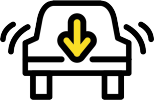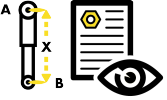BEFORE DISMANTLING

1. Carefully read the procedure recommended by the manufacturer, or the corresponding technical manual.

2. When necessary, clean vehicle surfaces located near the suspension unit.

3. Based on the suspension design, either leave the vehicle supported by its wheels or lift vehicle off the ground.

4. Carefully observe the position of the original shock absorbers and take note of how the pieces are placed. (In some shock absorbers, especially horizontal hydraulic units, the direction of the assembly and/or external identifications are important.)

5. Make sure you have all tools necessary to complete the job.

DURING MOUNTING

1. Do not use a pneumatic gun. This could risk turning the shank/rod and scratching its chrome surface during tightening. This damage could deteriorate the shaft seal, allowing oil to leak from the unit.

2. Never secure the piston rod with conventional pliers, as this would damage the chrome, causing the oil shaft seal to fail and thereby disabling the shock absorber. Always use specialised tools for each type of application.

3. Shock absorbers should always be fitted in pairs.

4. Prime the shock absorber before fitting. (This step is not necessary for high-pressure mono-tube type units.)

5. Use a torque wrench to tighten the rubber mounting bushes of the top mounting kit. Failure to follow torque specifications could damage and severely reduce service life of bushes.

6. For shocks with “loop” type end connections featuring rubber bushings:
a. On new, dismantled shock absorbers, mark (with a line under the dust cover) the distance between the pins of the bushes to which the connections of the shock absorber should be tightened, according to the manufacturer’s instructions.
b. With the vehicle on the hoist, tighten the superior and inferior assembly screws – without reaching final torque setting – in such a way that the bushes do not become blocked.

6. For shocks with “loop” type end connections featuring rubber bushings:
c. When the vehicle is supported by its own wheels, move the chassis slightly so that all the suspension pieces settle into position. Make certain the shock absorber is correctly placed by referring to the mark made in step (a.) above, before tightening the screws with the torque wrench.

6. For shocks with “loop” type end connections featuring rubber bushings:
d. Follow the manufacturer’s torque settings of all screws.

7. Once the wheels are mounted, check tyre pressure.

8. Check alignment of the vehicle’s wheels.

9. Perform a dynamic test with the vehicle to ensure all the pieces function correctly before returning it to the customer.

10. Correct fitting procedure for avoiding Loss of functionality due to incorrect fixture tightening.
STRUTS EQUIPPED WITH CIR-CLIP

1. On vehicles equipped with cir-clip shock absorbers, it is common to see a cir-clip ring that has moved out of position and damaged the piston rod. This fault is caused by improper tightening of the nut securing the series of upper elements against the cir-clip. (See nut “B” in drawing.)
This nut must be tightened to 1.5 daN.m to 3 daN.m. (Finger tightening this nut produces torque of around 2 daN.m.) Insufficient torque could cause unwanted vibration and noise, while excessive torque can move the cir-clip from its proper position, thereby damaging the shock and other components.

2. The use of the right tool in the assembly and dismantling process is one of the most important factors to guarantee the perfect operation of the new components of the suspension system.

3. Once the wheels are mounted, check tyre pressure.

4. Check the alignment of the vehicle’s wheels.

5. Carry out a dynamic test with the car, to ensure that all the pieces function correctly before delivering it to the user.
Note: For informational purposes only. We are not liable for any damages resulting from your reliance on this content

Watch the video for how to replace front shock absorbers on a Mercedes A-Class.
Watch the video for how to replace rear Shock Absorbers on a Hyundai Santafe II.
Find more videos on our Monroe® Youtube channel.

ARE YOU LOOKING FOR A SHOCK ABSORBER?
Discover Monroe’s shock absorber range or visit the eCatalogue to find out which shock absorber fits your vehicle.

